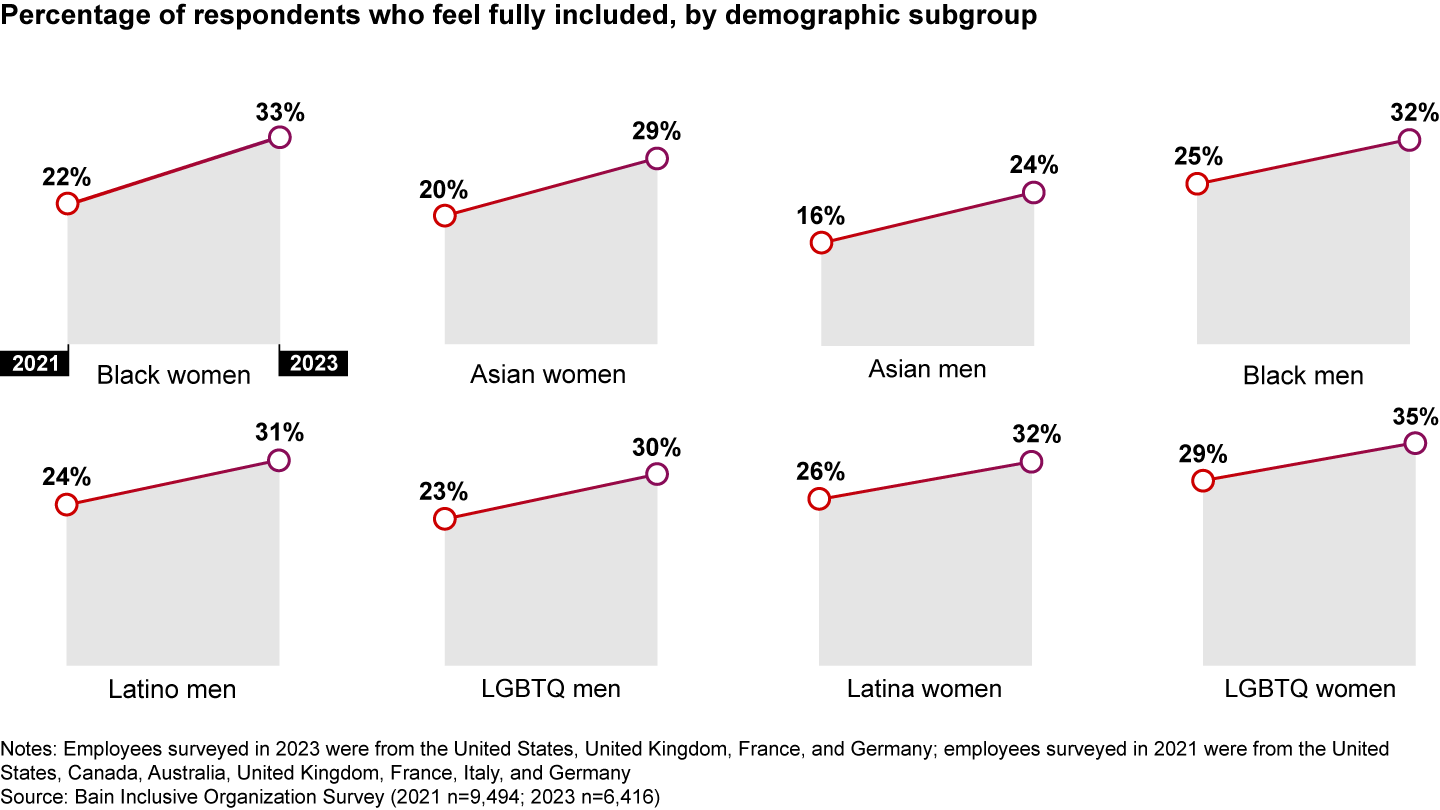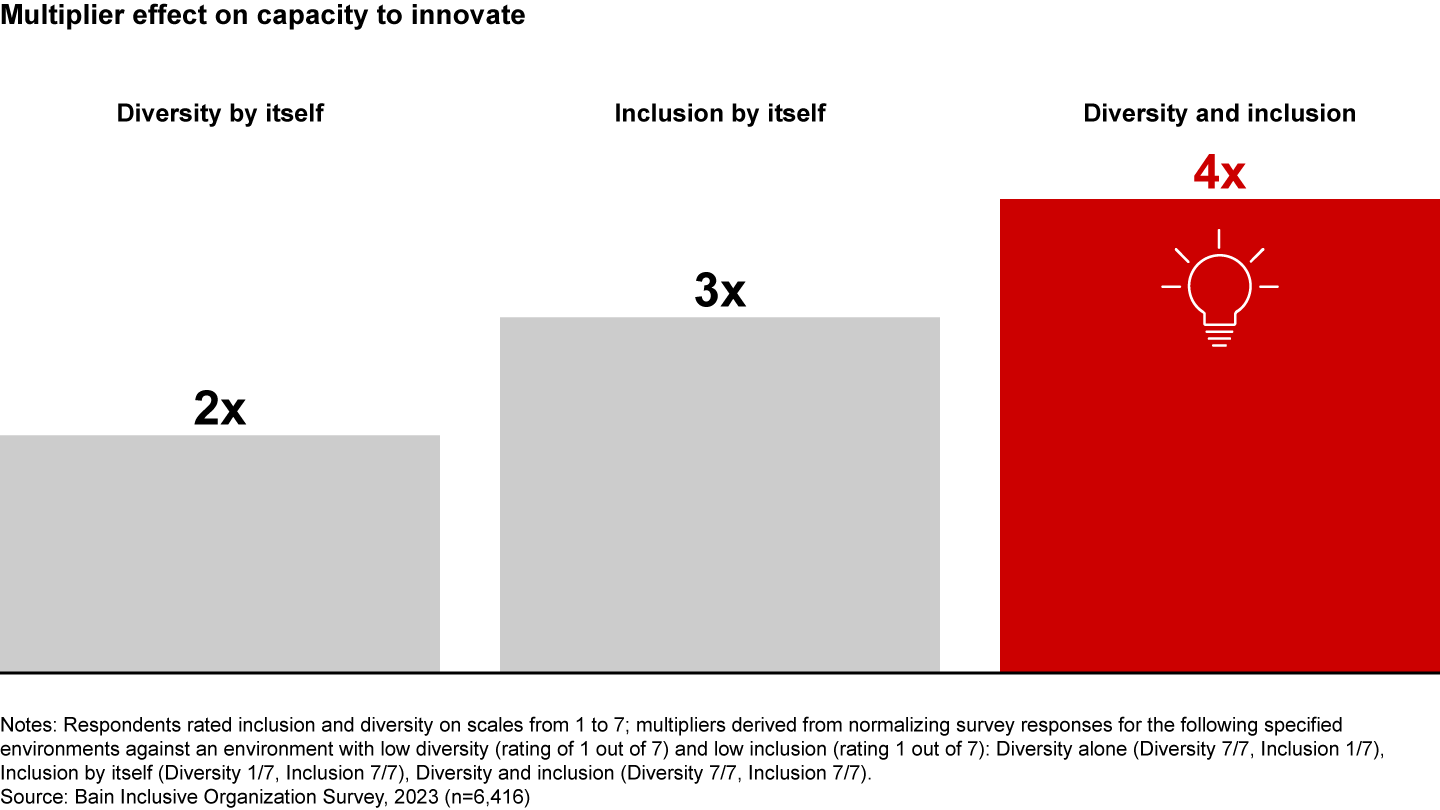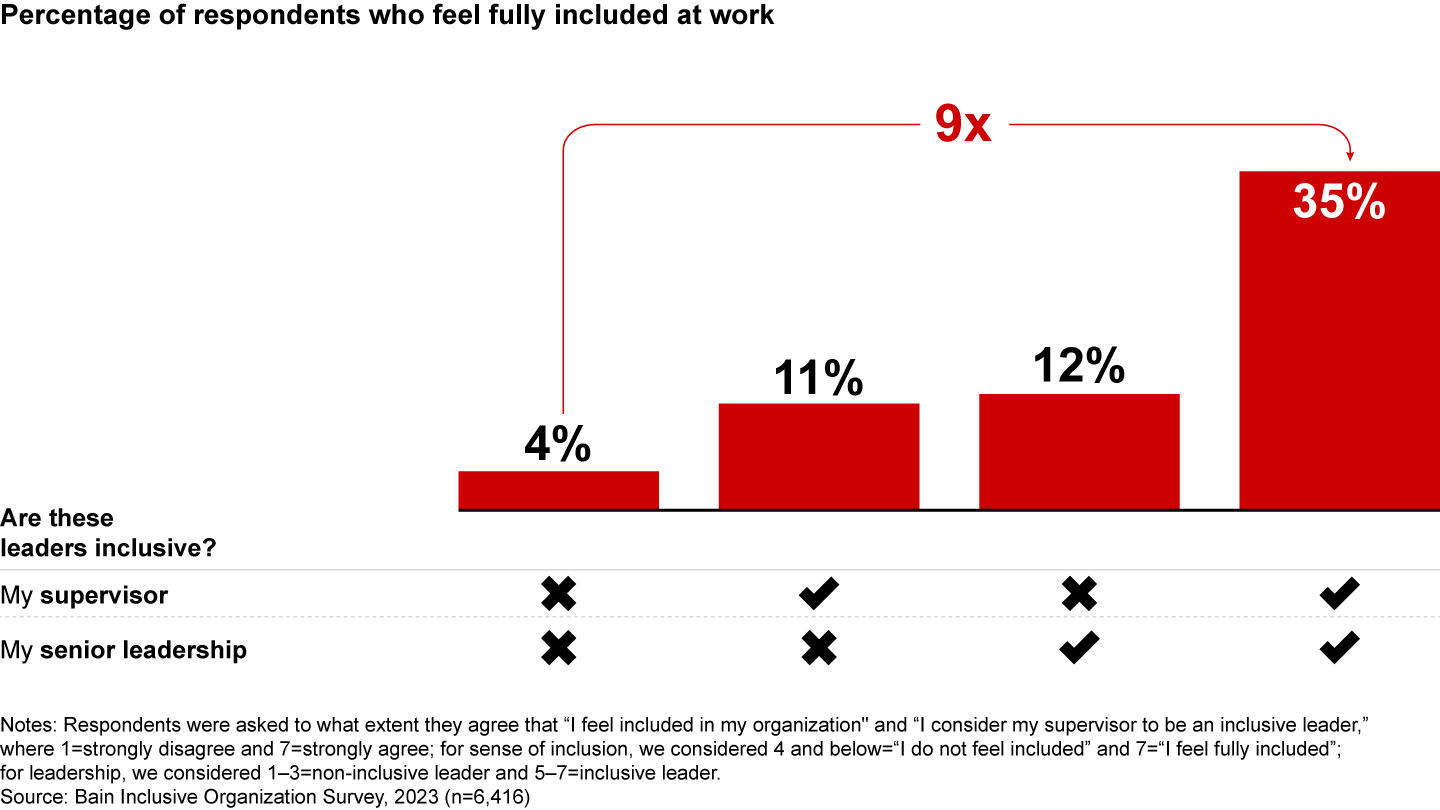Good news for companies seeking to foster inclusion and belonging for their employees: Intentional investments really work. In the last few years, many companies have been setting and communicating clear ambitions to create more inclusive workplaces and backing up these ambitions with specific initiatives and programs. Our latest research, in which we surveyed more than 6,000 employees across four countries, has found that employees who have seen their companies intentionally invest in inclusion since 2020 are three times more likely to feel fully included than employees who have not seen such investment from their employers.
Among historically underrepresented groups including Black, Latino, Asian, and LGBTQ employees, inclusion scores have risen for every group, and have increased overall by an average of seven percentage points between 2021 and 2023 (see Figure 1.)

The strong increases in inclusion scores among historically underrepresented populations make sense given that inclusion efforts are often driven by DEI (diversity, equity, and inclusion) teams with a mandate to focus on specific groups. Yet much of what we have learned about inclusion suggests the need to apply these strategies broadly across organizations.
Why inclusion matters—for everyone
Making everyone feel they belong at work is—or should be—an integral part of any organization’s talent and business strategies. Why? For one thing, employees who feel excluded are almost certain to perform at less than their full potential; neuroscience has shown that the human brain processes exclusion in ways that are similar to how it processes physical pain.
Employees who have seen their companies intentionally invest in inclusion over the last three years are three times more likely to feel fully included.
On the flip side, as we revealed in “The Fabric of Belonging: How to Weave an Inclusive Culture,” inclusion and belonging unlock employees’ highest potential, igniting the creativity, problem-solving capacity, and innovation needed to drive superior business results.
It is worth noting that diversity and inclusion are separate (though interrelated) factors in boosting team performance. For example, many studies have shown that more diverse teams generate more innovative ideas, and our research corroborates this: Having teams that are highly diverse increases an organization’s capacity for innovation twofold. Teams that are highly inclusive without being diverse increase innovative capacity threefold, and the multiplier rises to four with teams that are both diverse and inclusive (see Figure 2).

Diversity without inclusion will not get you as far you want to go. While diversity may expand the variety of perspectives brought to the table, it takes inclusion—which gives people more of a voice and creates a “safe to be brave” culture where they are willing to challenge the status quo—to unlock the full potential of diversity on a team.
Inclusion has other business benefits. Approximately 50% of all job seekers now say they view inclusion as very important in a prospective employer. Employees who report feeling fully included are 12 times more likely to promote their companies to others. Finally, inclusion has enormous benefits for retention: Employees who report feeling they truly belong at work are four to eight times more likely to remain with their organization than those in similar demographics who do not feel they belong. Making sure employees feel they belong also helps maintain and improve the levels of diversity that many companies have worked hard to achieve. Without active inclusion efforts, those same companies may risk becoming less diverse if members of underrepresented groups do not feel they belong and leave as a result.
A strategic approach to inclusion
It is clear that fostering inclusion and belonging has very tangible business benefits. Yet despite the success some companies have already achieved, there is still much room for improvement: In our most recent research, no more than 35% of any demographic group of employees said they feel fully included at work.
No more than 35% of any demographic group feels fully included at work today.
Employers clearly have a long way to go to foster inclusion for all employees, across all populations. Yet while inclusion for all is a necessity, it also makes sense to focus on specific areas where inclusion can have an especially strong business impact. The challenge is to combine breadth and precision.
Scaling inclusion efforts effectively across an organization is complex because, as we showed in “The Fabric of Belonging,” what drives inclusion most effectively varies by population. Yet there are a few universal enablers of inclusion that have high impact for everyone, including clear career pathways and investment in professional growth through mentorship and sponsorship programs. These universal enablers belong in any organization’s inclusion efforts.
Organizations should also selectively bolster investment where inclusion can create the most impact for the business. This means looking beyond historically underrepresented populations to consider specific teams, roles, or functions where improved innovation, creativity, problem solving, and talent outcomes will maximize business value from inclusion. For example, you might prioritize teams with unique perspectives, such as call center employees whose frontline interactions with customers may help generate new ideas for improving customer experience. You might also target company leadership and functions such as R&D or marketing to maximize innovation and problem-solving skills and create real business impact.
Organizations should also selectively bolster investment where inclusion can create the most impact for the business.
Mobilizing the whole organization
The strategic approach to inclusion and belonging we have outlined here offers a way of making inclusion a central part of your whole enterprise talent strategy, in support of your larger business strategy.
Effectively implementing such an approach requires mobilizing the whole organization by taking these steps:
Creating an inspiring vision of how inclusion benefits the business as well as everyone in the organization
An inspiring vision of inclusion must explain in concrete ways how inclusion benefits individuals, their teams, and the business. It enables employees to feel more comfortable and be able to do their best work; helps individuals and teams feel more willing to challenge the status quo; and makes the organization as a whole more innovative and productive. Perhaps most important, an inspiring vision makes it clear that inclusion is for everyone and benefits everyone.
Engaging and enabling the organization to act on the vision
Engaging and enabling the organization involves two distinct efforts. Engaging is about motivating people to take action by identifying individuals who will then champion inclusion at all levels of the organization, talking about the vision, and enlisting others in its pursuit. Enabling is about teaching people how to practice inclusion—not only through classroom training but, even more so, by creating opportunities for individuals to share experiences and practice taking authentic personal actions for fostering inclusion.
One useful way of giving people opportunities to practice inclusion is by encouraging them to adopt “micro-missions”—a term we use to mean small actions an individual commits to practicing in their day-to-day work routines. A micro-mission could be something as small as a leader resolving, “I’m going to invite more junior people to speak before I speak.” Or it could be something bigger, such as a person saying, “I’m going to learn about unconscious bias and what I can do to mitigate it.”
Investing differentially in leaders
Investing differentially in leadership means identifying both the authentic actions that best promote inclusion and belonging as well as the leaders who, because they engage in these actions, can best teach by example. When it comes to inclusion, leaders have an outsized impact on the behaviors and even the sentiments of others; indeed, employees are nine times more likely to feel fully included when they perceive both their supervisors and senior management as inclusive (see Figure 3).

All that said, the whole idea of creating a more inclusive organization can seem daunting, even overwhelming. The topic is sensitive and personal. An organization may have many places where inclusion efforts are needed but lack a clear owner for any of the work. It can be hard to know where to start. The approach to inclusion and belonging we have described here is meant to offer guidance for the journey—but at some point you have to decide to just get started.
As the journey unfolds, progress will be nonlinear, new challenges will crop up, and organizations will have to learn and adapt as they go. But as people in your organization begin to experience inclusion as a lived reality, you will begin to see other kinds of change: from a workforce that views its work as “just a job” to one that is deeply invested; from a company that has to sell itself to top talent to one where employees do the selling themselves; from a workplace where people play it safe to one where it feels safe to be brave and challenge the status quo.
These are the ultimate benefits of inclusion and belonging for everyone, and they are within every company’s reach.
This report would not have been possible without the valuable research and analysis support of Tiffany Chiang, Justin Long, Richard Pettey, and the Bain BCN team. The authors thank them for their important contributions.


